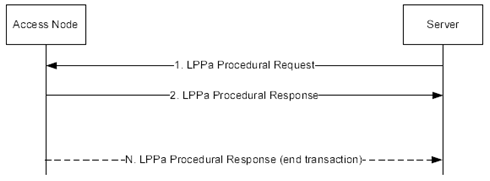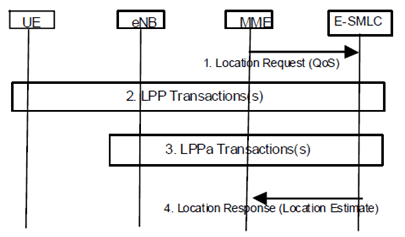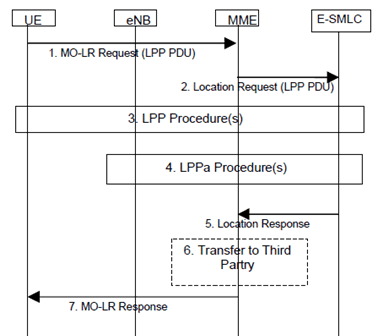Content for TS 36.305 Word version: 18.0.0
7.2 General LPPa Procedures for UE Positioning
7.2.1 LPPa Procedures
7.2.2 LPPa transaction types
7.3 Service Layer Support using combined LPP and LPPa Procedures
7.3.1 NI-LR and MT-LR Service Support
7.3.2 MO-LR Service Support
...
...
7.2 General LPPa Procedures for UE Positioning p. 36
7.2.1 LPPa Procedures p. 36
Positioning and data acquisition transactions between an E-SMLC and eNodeB are modelled by using procedures of the LPPa protocol. There are two types of LPPa procedures:
- UE associated procedure, i.e. transfer of information for a particular UE (e.g. positioning measurements)
- Non UE associated procedure, i.e. transfer of information applicable to the eNodeB and associated TPs (e.g. eNB/TP timing differences)

Figure 7.2.1-1 shows a single LPPa transaction. The transaction is terminated in step 2 in the case of a non UE associated procedure. For a UE associated procedure to gather information concerning the access node, additional responses may be allowed (e.g. sending of updated information periodically and/or whenever there is some significant change). In this case, the transaction may be ended after some additional responses. In the LPPa protocol, the described transaction may be realized by the execution of one procedure defined as a request and a response, followed by one or several procedures initiated by the eNB (each procedure defined as a single message) to realize the additional responses. The Correlation ID provided by the MME in the LCS-AP PDU encapsulating the LPPa PDU may be used by the E-SMLC to identify the target UE positioning session.
7.2.2 LPPa transaction types p. 36
7.2.2.1 Location information transfer p. 36
The term "location information" applies both to an actual position estimate and to values used in computing position (e.g., radio measurements or positioning measurements). It is delivered in response to a request.

Step 1.
The server sends a request for location related information to the eNodeB, and indicates the type of location information needed and associated QoS. The request may refer to a particular UE.
Step 2.
In response to step 1, the eNodeB transfers location related information to the server. The location related information transferred should match the location related information requested in step 1.
Step 3.
If requested in step 1, the eNodeB may transfer additional location related information to the server in one or more additional LPPa messages when the positioning method is E-CID.
7.3 Service Layer Support using combined LPP and LPPa Procedures p. 37
As described in TS 23.271, UE-positioning-related services can be instigated from the EPC in the case of an NI-LR or MT-LR location service, or from the UE in the case of an MO-LR location service. The complete sequence of operations in the EPC is defined in TS 23.271. This clause defines the overall sequences of operations that occur in the E-SMLC, E-UTRAN and UE as a result of the EPC operations.
Some flows in this scenario apply only in particular situations (e.g., only when the UE is in connected mode). The lower-layer details of such cases are not shown in the diagrams; for instance, the process of paging a UE to bring it to connected mode from idle is not explicitly indicated in these diagrams.
7.3.1 NI-LR and MT-LR Service Support p. 37
Figure 7.3.1-1 shows the sequence of operations for an NI-LR or MT-LR location service, starting at the point where the MME initiates the service in the E-SMLC.

Figure 7.3.1-1: UE Positioning Operations to support an MT-LR or NI-LR
(⇒ copy of original 3GPP image)
(⇒ copy of original 3GPP image)
Step 1.
The MME sends a location request to the E-SMLC for a target UE and may include associated QoS.
Step 2.
The E-SMLC may obtain location related information from the UE and/or from the serving eNode B. In the former case, the E-SMLC instigates one or more LPP procedures to transfer UE positioning capabilities, provide assistance data to the UE and/or obtain location information from the UE. The UE may also instigate one or more LPP procedures after the first LPP message is received from the E-SMLC (e.g., to request assistance data from the E-SMLC).
Step 3.
If the E-SMLC needs location related information for the UE from the eNode B, the E-SMLC instigates one or more LPPa procedures. Step 3 is not necessarily serialised with step 2; if the E-SMLC and eNode B have the information to determine what procedures need to take place for the location service, step 3 could precede or overlap with step 2.
Step 4.
The E-SMLC returns a location response to the MME with any location estimate obtained as a result of steps 2 and 3.
7.3.2 MO-LR Service Support p. 38
Figure 7.3.2-1 shows the sequence of operations for an MO-LR service, starting at the point where an LCS Client in the UE or the user has requested some location service (e.g., retrieval of the UE's location or transfer of the UE's location to a third party).

Step 1.
The UE sends a NAS level MO-LR location service request message to the MME. The MO-LR location service request message may carry an LPP PDU to instigate one or more LPP procedures to transfer capabilities, request assistance data and/or transfer location information (e.g. location measurements).
Step 2.
The MME sends a location request to the E-SMLC and includes any LPP PDU received in step 1.
Step 3.
The E-SMLC may obtain location related information from the UE and/or from the serving eNode B. In the former case or if an immediate response is needed to any LPP procedure instigated by the UE in step 1 (e.g., a request for assistance data), the E-SMLC instigates one or more LPP procedures to transfer UE positioning capabilities, provide assistance data to the UE and/or obtain location information from the UE. The UE may also instigate further LPP procedures after the first LPP message is received from the E-SMLC (e.g., to request assistance data or to request further assistance data).
Step 4.
If the E-SMLC needs location related information for the UE from the eNode B, the E-SMLC instigates one or more LPPa procedures. Step 4 may also precede step 3 or occur in parallel with it.
Step 5.
The E-SMLC returns a location response to the MME with any location estimate obtained as a result of steps 3 and 4.
Step 6.
If the UE requested location transfer to a third party the MME transfers the location received from the E-SMLC in step 5 to the third party as defined in TS 23.271.
Step 7.
The MME sends a NAS level MO-LR location service response message to the UE.